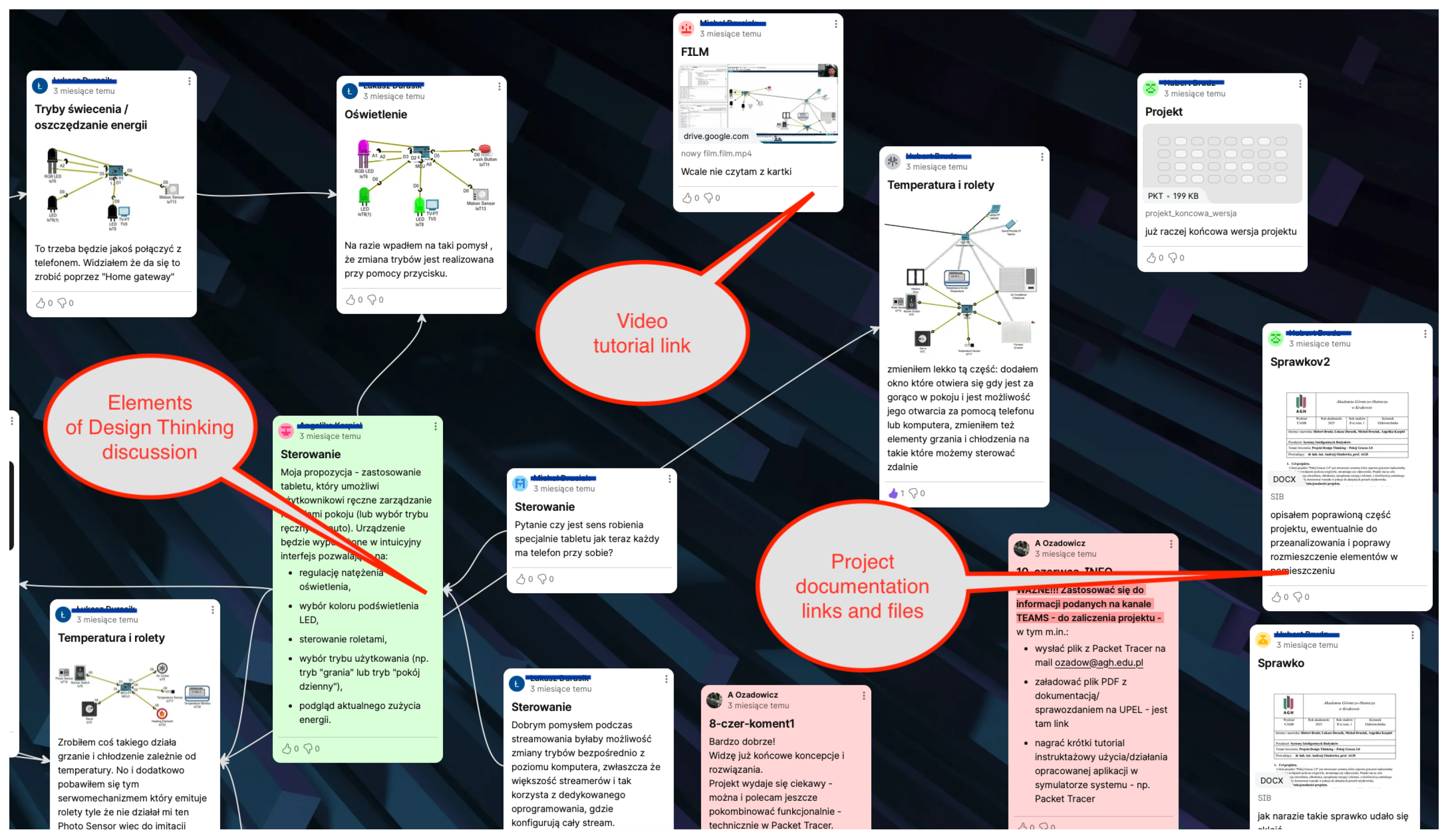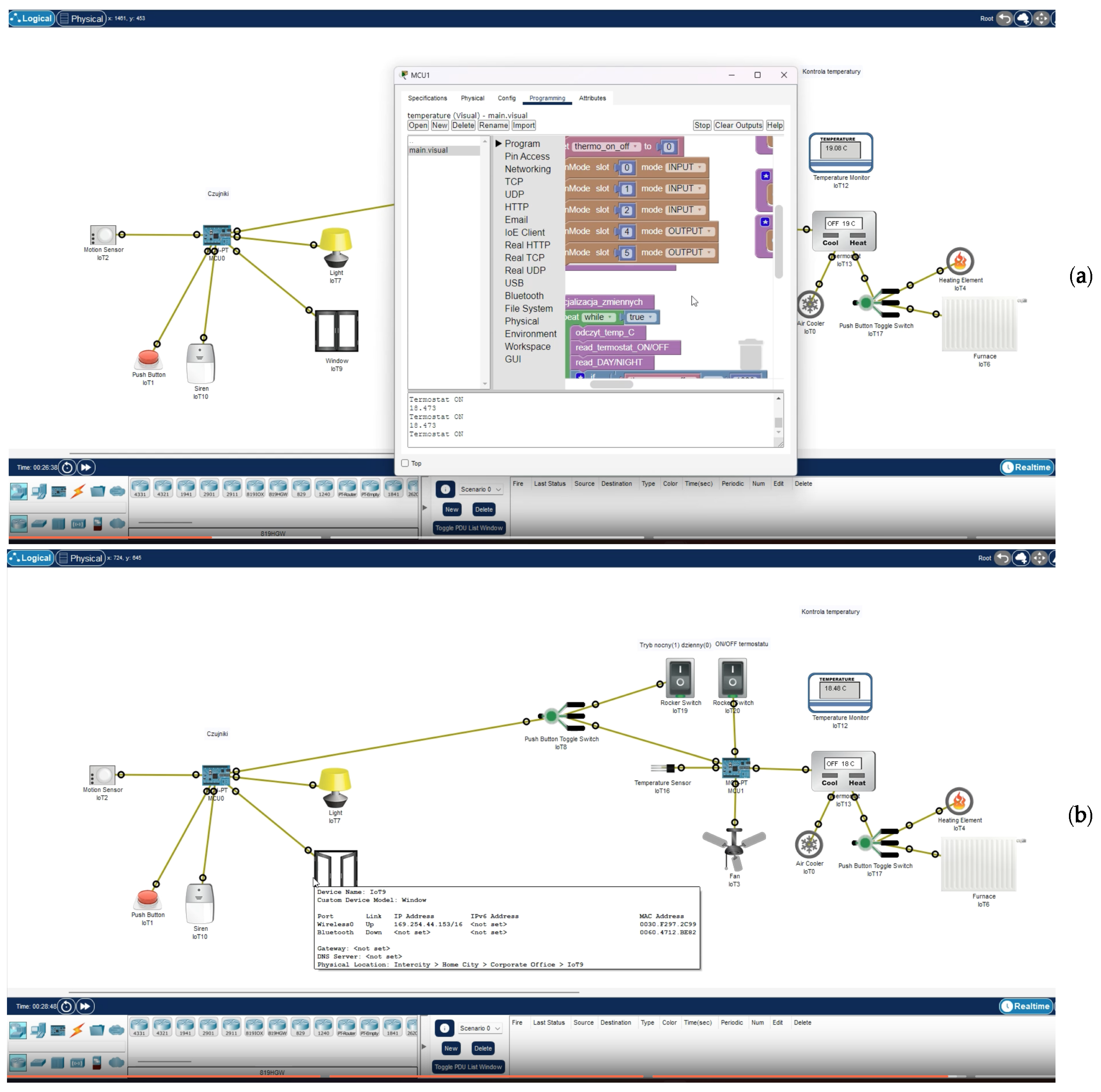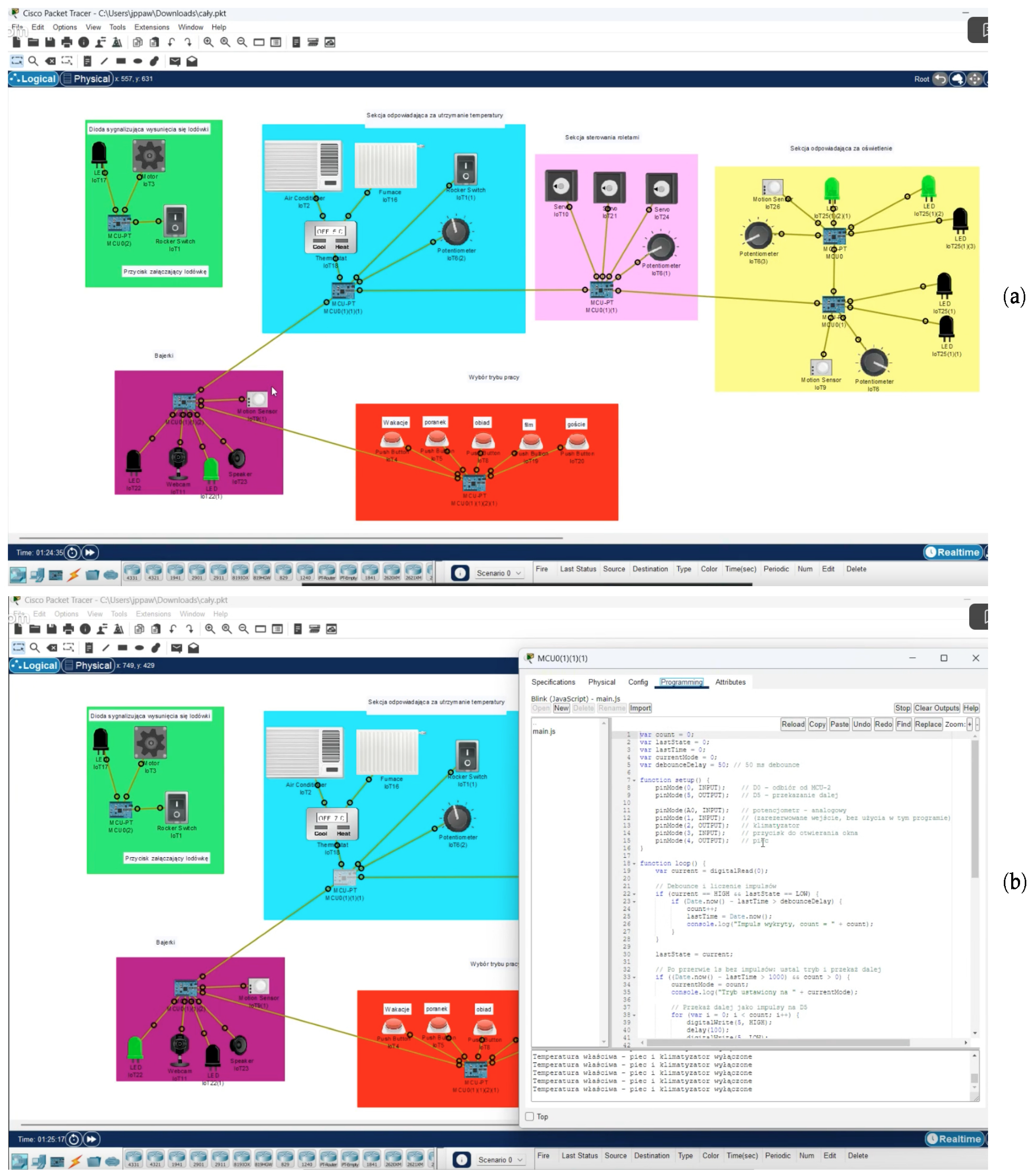Integrating Design Thinking Approach and Simulation Tools in Smart Building Systems Education: A Case Study on Computer-Assisted Learning for Master’s Students
Abstract
1. Introduction
1.1. Simulation Tools in Engineering Education
1.2. Blended Learning in Higher Engineering Education
1.3. Aim and Contribution of the Study
2. Materials—Related Work
2.1. Design Thinking in Engineering Education
2.2. Simulation Tools in Smart Building and IoT Education
2.3. Blended Learning and Hybrid Collaboration in Engineering Education
2.4. Synthesis of Trends and Research Implications
3. Methodology
3.1. Course Context
3.2. Blended Learning Framework
3.3. Project Framework
3.4. Tools and Deliverables
3.5. Design Thinking Integration
3.6. Evaluation Rules and Final Remarks
4. Results
4.1. Student Project Outcomes
4.1.1. Insights from Design Thinking Discussions
4.1.2. Prototyping in Cisco Packet Tracer and Supporting Documentation
4.2. Survey Results
4.2.1. Technical and Methodological Aspects
4.2.2. Organizational Aspects and Soft Skills
4.2.3. Insights from Open-Ended Questions
- Earlier projects start to reduce the end-of-semester workload: “Completing such a project at a different time would make it less stressful”;
- More structured consultations and instructor support during design stages: “On-site group consultations with the instructor are necessary”;
- Opportunities for intergroup presentations to exchange feedback: “Adding the ability to present the project to other groups and discuss it together”.
5. Discussion
6. Conclusions
Funding
Data Availability Statement
Acknowledgments
Conflicts of Interest
Abbreviations
| AI | Artificial Intelligence |
| BL | Blended Learning |
| DT | Design Thinking |
| FC | Flipped Classroom |
| ICT | Information and Communication Technology |
| IoT | Internet of Things |
Appendix A
- Evaluation of the Design Thinking Project—2025
- Please provide feedback on the recently completed project. Evaluate the selected aspects.
- The survey is completely anonymous, without collecting any information or data about the students.
- Q1. Project goals and tasks
- How clearly were the project goals and your tasks defined?
- Not clear at all
- Insufficiently clear
- Moderately clear
- Rather clear
- Very clear
- Q2. Which of the following tools did you find most helpful in the project implementation? (choose up to 3)
- Sweet Home 3D/Floorplanner
- Tinkercad
- Packet Tracer
- Padlet
- Design Thinking Canvas/Miro
- Other (please specify)
- Q3. How do you evaluate the use of the Design Thinking method in the project?
- Very helpful—facilitated understanding of needs and planning of solutions
- Rather helpful—structured the teamwork process
- Neutral—did not significantly affect the way of working
- Rather unhelpful—contributed little to the project
- I do not understand what this method was about
- Q4. Level of project difficulty
- How do you evaluate the level of difficulty of the project implementation?
- Too easy
- Adequate
- Sometimes difficult, but feasible
- Too difficult
- I was not able to complete the project
- Q5. Would you like to participate in a similar project in the future?
- Definitely YES
- Rather YES
- Neutral
- Rather NO
- Definitely NO
- Q6. How do you evaluate the benefits of participating in this project?
- Development of technical skills (IoT, automation, simulations):
- Very high
- High
- Medium
- Low
- None
- Teamwork and work organization:
- Very high
- High
- Medium
- Low
- None
- Understanding the concept of “smart home” in practice:
- Very high
- High
- Medium
- Low
- None
- Q7. Which aspects of this project were the most useful and valuable?
- (open-ended question)
- Q8. How would you improve this project?
- (open-ended question)
References
- Naccarelli, R.; Casaccia, S.; Pirozzi, M.; Revel, G.M. Using a Smart Living Environment Simulation Tool and Machine Learning to Optimize the Home Sensor Network Configuration for Measuring the Activities of Daily Living of Older People. Buildings 2022, 12, 2213. [Google Scholar] [CrossRef]
- Maggiulli, M.; Piscitelli, M.S.; Capozzoli, A. A Data-Driven Approach to Evaluate the Smart Readiness Indicator for the Functionality “Respond to Users’ Needs”. In Sustainability in Energy and Buildings 2023; Littlewood, J.R., Jain, L., Howlett, R.J., Eds.; Springer Nature: Singapore, 2024; pp. 589–599. [Google Scholar]
- Koh, J.H.L.; Chai, C.S.; Wong, B.; Hong, H.-Y. (Eds.) Design Thinking and Education. In Design Thinking for Education; Springer: Singapore, 2015; pp. 1–15. [Google Scholar]
- McLaughlin, J.E.; Chen, E.; Lake, D.; Guo, W.; Skywark, E.R.; Chernik, A.; Liu, T. Design Thinking Teaching and Learning in Higher Education: Experiences across Four Universities. PLoS ONE 2022, 17, e0265902. [Google Scholar] [CrossRef] [PubMed]
- Taimur, S.; Onuki, M. Design Thinking as Digital Transformative Pedagogy in Higher Sustainability Education: Cases from Japan and Germany. Int. J. Educ. Res. 2022, 114, 101994. [Google Scholar] [CrossRef]
- Kumar, B.; Padmanabha, V.; Dwivedi, R. Utilizing Packet Tracer Simulation to Modern Smart Campus Initiatives for a Sustainable Future. In Proceedings of the 2024 IEEE 12th International Conference on Smart Energy Grid Engineering (SEGE), Oshawa, ON, Canada, 18–20 August 2024; pp. 97–102. [Google Scholar]
- Demeter, R.; Kovari, A.; Katona, J.; Heldal, I.; Costescu, C.; Rosan, A.; Hathazi, A.; Thill, S. A Quantitative Study of Using Cisco Packet Tracer Simulation Software to Improve IT Students’ Creativity and Outcomes. In Proceedings of the 2019 10th IEEE International Conference on Cognitive Infocommunications (CogInfoCom), Naples, Italy, 23–25 October 2019; pp. 353–358. [Google Scholar]
- Alfarsi, G.; Jabbar, J.; Tawafak, R.M.; Malik, S.I.; Alsidiri, A.; Alsinani, M. Ghaliya Alfarsi Using Cisco Packet Tracer to Simulate Smart Home. Int. J. Eng. Res. Technol. 2020, 8, 670–674. [Google Scholar] [CrossRef]
- Kefalis, C.; Skordoulis, C.; Drigas, A. Digital Simulations in STEM Education: Insights from Recent Empirical Studies, a Systematic Review. Encyclopedia 2025, 5, 10. [Google Scholar] [CrossRef]
- Sellberg, C.; Nazari, Z.; Solberg, M. Virtual Laboratories in STEM Higher Education: A Scoping Review. Nord. J. Syst. Rev. Educ. 2024, 2. [Google Scholar] [CrossRef]
- Raes, A.; Detienne, L.; Windey, I.; Depaepe, F. A Systematic Literature Review on Synchronous Hybrid Learning: Gaps Identified. Learn. Environ. Res. 2020, 23, 269–290. [Google Scholar] [CrossRef]
- Ozadowicz, A. Interactivity—A Key Element of Blended Learning with Flipped Classroom Approach. In Proceedings of the 2022 IEEE 9th International Conference on e-Learning in Industrial Electronics (ICELIE), Brussel, Belgium, 17–20 October 2022; pp. 1–6. [Google Scholar]
- Gudoniene, D.; Staneviciene, E.; Huet, I.; Dickel, J.; Dieng, D.; Degroote, J.; Rocio, V.; Butkiene, R.; Casanova, D. Hybrid Teaching and Learning in Higher Education: A Systematic Literature Review. Sustainability 2025, 17, 756. [Google Scholar] [CrossRef]
- Meinel, C.; Schweiger, S. A Virtual Social Learner Community—Constitutive Element of MOOCs. Educ. Sci. 2016, 6, 22. [Google Scholar] [CrossRef]
- Singh, A.; Rocke, S.; Pooransingh, A.; Ramlal, C.J. Improving Student Engagement in Teaching Electric Machines Through Blended Learning. IEEE Trans. Educ. 2019, 62, 297–304. [Google Scholar] [CrossRef]
- Klentien, U.; Wannasawade, W. Development of Blended Learning Model with Virtual Science Laboratory for Secondary Students. Procedia Soc. Behav. Sci. 2016, 217, 706–711. [Google Scholar] [CrossRef]
- Ożadowicz, A. Modified Blended Learning in Engineering Higher Education during the COVID-19 Lockdown—Building Automation Courses Case Study. Educ. Sci. 2020, 10, 292. [Google Scholar] [CrossRef]
- Gren, L. A Flipped Classroom Approach to Teaching Empirical Software Engineering. IEEE Trans. Educ. 2020, 63, 155–163. [Google Scholar] [CrossRef]
- Collado-Valero, J.; Rodríguez-Infante, G.; Romero-González, M.; Gamboa-Ternero, S.; Navarro-Soria, I.; Lavigne-Cerván, R. Flipped Classroom: Active Methodology for Sustainable Learning in Higher Education during Social Distancing Due to COVID-19. Sustainability 2021, 13, 5336. [Google Scholar] [CrossRef]
- Muñoz, C.B.; Nanclares, N.H.; Murillo Zamorano, L.R.; Sánchez, J.Á.L. Design Thinking in Higher Education. In Gamification and Design Thinking in Higher Education; Routledge: New York, NY, USA, 2023; pp. 37–61. [Google Scholar]
- Tekaat, J.L.; Anacker, H.; Dumitrescu, R. The Paradigm of Design Thinking and Systems Engineering in the Design of Cyber-Physical Systems: A Systematic Literature Review. In Proceedings of the ISSE 2021-7th IEEE International Symposium on Systems Engineering, Vienna, Austria, 13 September–13 October 2021. [Google Scholar]
- AL Sultan, O.K.T.; Suleiman, A.R. Simulation of IoT Web-Based Standard Smart Building Using Packet Tracer. In Proceedings of the 2021 7th International Engineering Conference “Research & Innovation amid Global Pandemic” (IEC), Erbil, Iraq, 24–25 February 2021; pp. 48–53. [Google Scholar]
- Mishra, A.; Ghayar, J.; Pendam, R.; Shinde, S. Design and Implementation of Smart Home Network Using Cisco Packet Tracer. ITM Web Conf. 2022, 44, 01008. [Google Scholar] [CrossRef]
- Barriga, J.A.; Clemente, P.J.; Sosa-Sanchez, E.; Prieto, A.E. SimulateIoT: Domain Specific Language to Design, Code Generation and Execute IoT Simulation Environments. IEEE Access 2021, 9, 92531–92552. [Google Scholar] [CrossRef]
- Mwansa, G.; Ngandu, M.R.; Dasi, Z.S. Enhancing Practical Skills in Computer Networking: Evaluating the Unique Impact of Simulation Tools, Particularly Cisco Packet Tracer, in Resource-Constrained Higher Education Settings. Educ. Sci. 2024, 14, 1099. [Google Scholar] [CrossRef]
- Limaymanta, C.H.; Apaza-Tapia, L.; Vidal, E.; Gregorio-Chaviano, O. Flipped Classroom in Higher Education: A Bibliometric Analysis and Proposal of a Framework for Its Implementation. Int. J. Emerg. Technol. Learn. (iJET) 2021, 16, 133. [Google Scholar] [CrossRef]
- Andrews, C.D.M.; Mehrubeoglu, M.; Etheridge, C. Hybrid Model for Multidisciplinary Collaborations for Technical Communication Education in Engineering. IEEE Trans. Prof. Commun. 2021, 64, 52–65. [Google Scholar] [CrossRef]
- McGibney, A.; Rea, S.; Ploennigs, J. Open BMS-IoT Driven Architecture for the Internet of Buildings. In Proceedings of the IECON 2016-42nd Annual Conference of the IEEE Industrial Electronics Society, Florence, Italy, 23–26 October 2016; pp. 7071–7076. [Google Scholar]
- Noga, M.; Ożadowicz, A.; Grela, J. Modern, Certified Building Automation Laboratories AutBudNet–Put “Learning by Doing” Idea into Practice. Electr. Rev. 2012, 88, 137–141. [Google Scholar]









| Project Stage | Tools Used | Expected Learning Outcomes |
|---|---|---|
| Introduction & preparation | Flipped Classroom lecture (online), Moodle resources | Understanding of DT methodology and project scope |
| Organizational meeting | On-site session in laboratory | Clarity of project goals, team roles, and assessment criteria |
| Design Thinking process | Padlet (collaborative platform) | User analysis, ideation, documentation, teamwork |
| Spatial design | Sweet Home 3D /Floorplanner | Planning room layouts and placement of automation and smart devices |
| Simulation & prototyping | Cisco Packet Tracer | Virtual modeling of IoT-based smart building functions, iterative refinement |
| Presentation & evaluation | Padlet (final documentation), video tutorials | Communication of solutions, peer and instructor feedback |
| Tool | Purpose | Educational Value |
|---|---|---|
| Sweet Home 3D ver. 7.5; manufacturer: Space Mushrooms, Milan, Italy Floorplanner; manufacturer: Floorplanner, Rotterdam, the Netherlands (cloud-based platform, features as of May 2025) | Creating visual room layouts and planning the placement of automation and smart devices before functional modeling | Enhancing spatial awareness, contextualizing technical designs, and improving the integration of automation systems into realistic environments |
| Cisco Packet Tracer ver. 8.2.2; manufacturer: Cisco Networking Academy, San Jose, California, USA | Virtual modeling of IoT-based smart building systems and testing automation scenarios; includes dedicated smart home and smart building simulation modules with support for open IoT technologies | Developing applied skills in IoT network design and iterative prototyping |
| Padlet; manufacturer Padlet (startup), San Francisco, California USA (educational license, features as of 2025) | Collaborative documentation of Design Thinking stages, idea sharing, and feedback exchange | Enhancing teamwork, asynchronous collaboration, and project management skills |
| Loom; manufacturer: Loom Inc., San Francisco, California USA (online tool, features as of 2005) | Recording short video tutorials demonstrating system functionalities | Improving digital communication and presentation competencies |
| MS Word; manufacturer: Microsoft Corp., Redmond, Washington, USA OpenOffice; manufacturer: The Apache Software Foundation, Forest Hill, Maryland, USA LaTeX Overleaf; manufacturer: Overleaf Ltd., London, United Kingdom (various versions, depend on students licenses) | Preparing simplified technical documentation summarizing system architecture, functionalities, and user-oriented features | Building technical reporting skills and translating complex systems into accessible documentation |
| Design Thinking Stage | Key Students’ Activities | Project Outputs |
|---|---|---|
| Empathize | In-depth analysis of assigned user groups, mapping daily routines, identifying pain points and expectations for smart living environments (Padlet) | User profiles with documented needs and priorities |
| Define | Synthesizing findings into structured problem statements, identifying design constraints and measurable project goals (Padlet) | Clear problem definitions with prioritized design objectives |
| Ideate | Generating a wide range of solution concepts, group discussions to evaluate feasibility and potential impact, selecting the most promising ideas for further development (Padlet) | Conceptual solution outlines and prioritized proposals |
| Prototype | Translating selected ideas into functional system models within the simulation environment (Sweet Home 3D, Packet Tracer), establishing logical automation structures, designing device interactions, and programming universal microcontroller units available in the software to implement custom smart building functions | Configured simulation models representing realistic smart building scenarios with programmed automation logic |
| Test | Presenting the functioning of designed applications through instructional video tutorials, highlighting different organizational approaches to activating and managing smart functions (Packet Tracer) | Video presentations demonstrating system operation and documenting varied strategies for function activation |
| Tool | Percentage of Students |
|---|---|
| Cisco Packet Tracer | 94% |
| Sweet Home 3D/Floorplanner | 72% |
| Padlet | 50% |
| DT Evaluation | Percentage of Students |
|---|---|
| Very helpful | 6% |
| Rather helpful | 61% |
| Neutral | 33% |
| Evaluation | Percentage of Students |
|---|---|
| Very high | 22% |
| High | 72% |
| Medium | 6% |
| Evaluation | Percentage of Students |
|---|---|
| Very high | 28% |
| High | 39% |
| Medium | 33% |
| Evaluation | Percentage of Students |
|---|---|
| Very clear | 28% |
| Rather clear | 28% |
| Medium | 22% |
| Insufficiently clear | 22% |
| Evaluation | Percentage of Students |
|---|---|
| Sometimes difficult but feasible | 83% |
| Adequate | 17% |
Disclaimer/Publisher’s Note: The statements, opinions and data contained in all publications are solely those of the individual author(s) and contributor(s) and not of MDPI and/or the editor(s). MDPI and/or the editor(s) disclaim responsibility for any injury to people or property resulting from any ideas, methods, instructions or products referred to in the content. |
© 2025 by the author. Licensee MDPI, Basel, Switzerland. This article is an open access article distributed under the terms and conditions of the Creative Commons Attribution (CC BY) license (https://creativecommons.org/licenses/by/4.0/).
Share and Cite
Ożadowicz, A. Integrating Design Thinking Approach and Simulation Tools in Smart Building Systems Education: A Case Study on Computer-Assisted Learning for Master’s Students. Computers 2025, 14, 379. https://doi.org/10.3390/computers14090379
Ożadowicz A. Integrating Design Thinking Approach and Simulation Tools in Smart Building Systems Education: A Case Study on Computer-Assisted Learning for Master’s Students. Computers. 2025; 14(9):379. https://doi.org/10.3390/computers14090379
Chicago/Turabian StyleOżadowicz, Andrzej. 2025. "Integrating Design Thinking Approach and Simulation Tools in Smart Building Systems Education: A Case Study on Computer-Assisted Learning for Master’s Students" Computers 14, no. 9: 379. https://doi.org/10.3390/computers14090379
APA StyleOżadowicz, A. (2025). Integrating Design Thinking Approach and Simulation Tools in Smart Building Systems Education: A Case Study on Computer-Assisted Learning for Master’s Students. Computers, 14(9), 379. https://doi.org/10.3390/computers14090379







